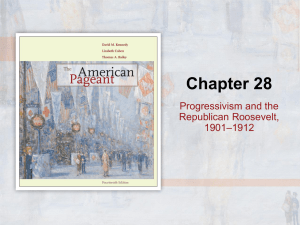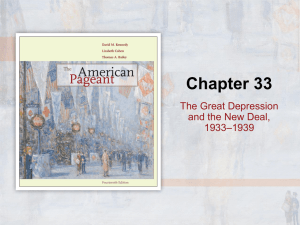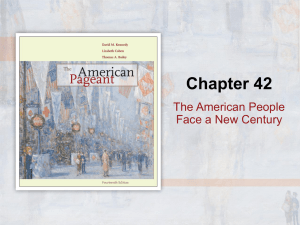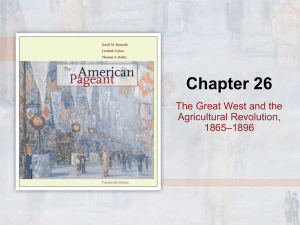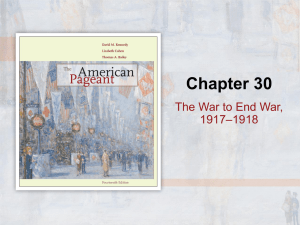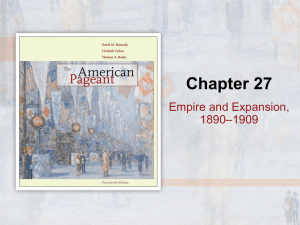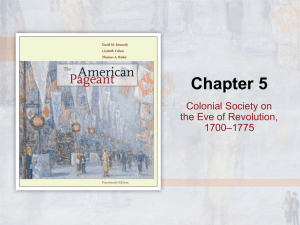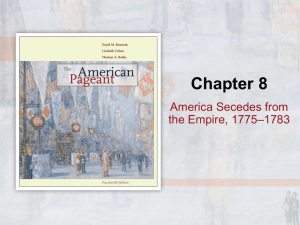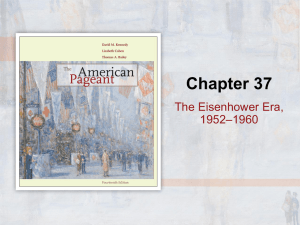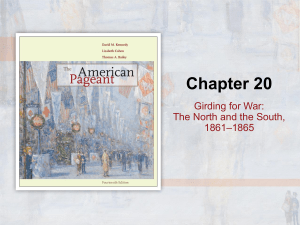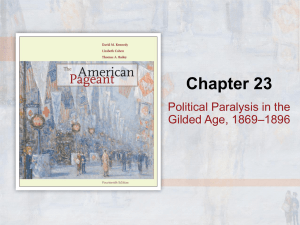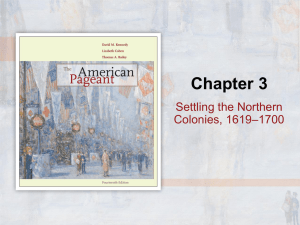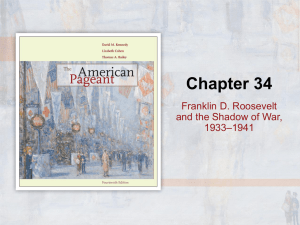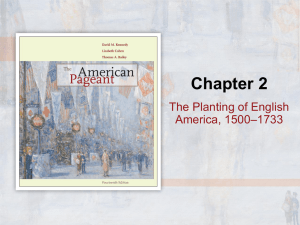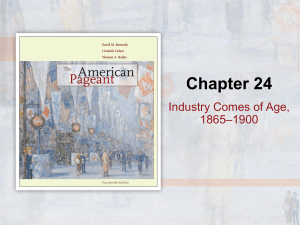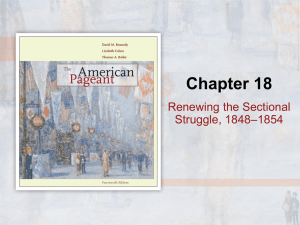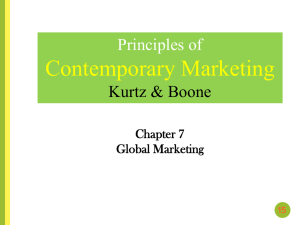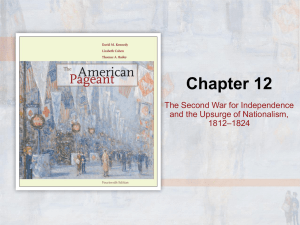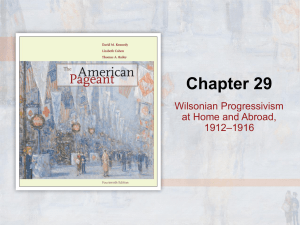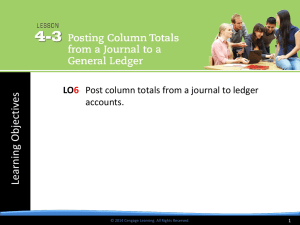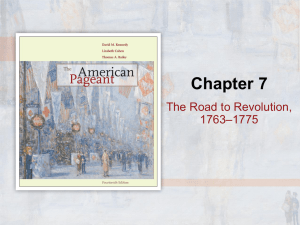Ch32
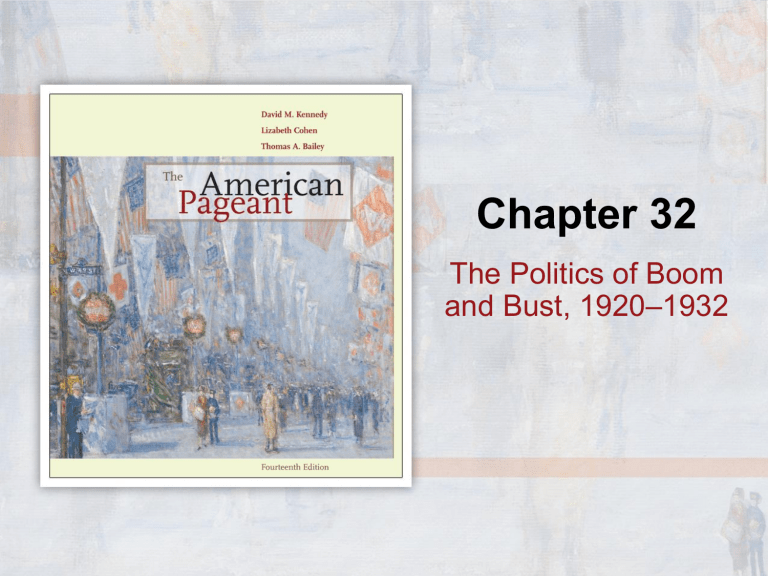
Chapter 32
The Politics of Boom and Bust, 1920 –1932
Question
The case of
Adkins v. Children’s Hospital
reversed
a) Holden v. Hardy
.
b) Lochner v. New York
.
c) Muller v. Oregon
.
d) Muller v. New York
.
Copyright © Cengage Learning. All rights reserved.
32 | 2
Answer
The case of
Adkins v. Children’s Hospital
reversed
a) Holden v. Hardy
.
b) Lochner v. New York
.
c) Muller v. Oregon
. (
correct
)
d) Muller v. New York
.
Hint: See page 799.
Copyright © Cengage Learning. All rights reserved.
32 | 3
Question
The Nine-Power Treaty of 1922 a) replaced the twenty-year-old Anglo-Japanese alliance.
b) bound Britain, Japan, France, and the United States to preserve the status quo in the Pacific.
c) scaled-down the navies of America and Britain, with parity in battleships and aircraft carriers, and Japan on the small end of a 5:5:3 ratio.
d) saw its signatories agree to nail wide open the Open
Door in China.
Copyright © Cengage Learning. All rights reserved.
32 | 4
Answer
The Nine-Power Treaty of 1922 a) replaced the twenty-year-old Anglo-Japanese alliance.
b) bound Britain, Japan, France, and the United States to preserve the status quo in the Pacific.
c) scaled-down the navies of America and Britain, with parity in battleships and aircraft carriers, and Japan on the small end of a 5:5:3 ratio.
d) saw its signatories agree to nail wide open the Open
Door in China. ( correct )
Hint: See page 802.
Copyright © Cengage Learning. All rights reserved.
32 | 5
Question
All of the following were true of the Kellogg-Briand Pact
EXCEPT a) defensive wars were no longer permitted.
b) it had quarreling nations take the pledge to foreswear war as an instrument of national policy.
c) officially known as the Pact of Paris, it was ultimately ratified by sixty-two nations.
d) it accurately —and dangerously—reflected the
American mind in the 1920s, which was all too willing to be lulled into a false sense of security.
Copyright © Cengage Learning. All rights reserved.
32 | 6
Answer
All of the following were true of the Kellogg-Briand Pact
EXCEPT a) defensive wars were no longer permitted. ( correct ) b) it had quarreling nations take the pledge to foreswear war as an instrument of national policy.
c) officially known as the Pact of Paris, it was ultimately ratified by sixty-two nations.
d) it accurately —and dangerously—reflected the
American mind in the 1920s, which was all too willing to be lulled into a false sense of security.
Hint: See page 803.
Copyright © Cengage Learning. All rights reserved.
32 | 7
Question
All of the following were true of the Teapot Dome Scandal
EXCEPT a) it involved priceless naval oil reserves at Teapot Dome
(Wyoming) and Elk Hills (California).
b) secretary of the navy, Albert B. Fall, induced the secretary of the interior, to transfer these valuable properties to the Navy
Department.
c) Fall leased the lands to oilmen Harry F. Sinclair and Edward L.
Doheny, but not until he had received bribes from Doheny and
Sinclair.
d) the two bribe givers were acquitted, while the bribe taker was convicted.
Copyright © Cengage Learning. All rights reserved.
32 | 8
Answer
All of the following were true of the Teapot Dome Scandal
EXCEPT a) it involved priceless naval oil reserves at Teapot Dome
(Wyoming) and Elk Hills (California).
b) secretary of the navy, Albert B. Fall, induced the secretary of the interior, to transfer these valuable properties to the Navy
Department. ( correct ) c) Fall leased the lands to oilmen Harry F. Sinclair and Edward L.
Doheny, but not until he had received bribes from Doheny and
Sinclair.
d) the two bribe givers were acquitted, while the bribe taker was convicted.
Hint: See pages 803 –804.
Copyright © Cengage Learning. All rights reserved.
32 | 9
Question
All of the following were true of the Good Neighbor Policy
EXCEPT a) Hoover’s arrival in the White House brought a more hopeful turn to relations with America’s southern neighbors.
b) the new president was deeply interested in the often-troubled nations below the Rio Grande.
c) world depression hardened an age-old aggressive attitude in the United States toward weak Latin neighbors.
d) Herbert Hoover engineered the foundation stones of the “Good
Neighbor” policy.
Copyright © Cengage Learning. All rights reserved.
32 | 10
Answer
All of the following were true of the Good Neighbor Policy
EXCEPT a) Hoover’s arrival in the White House brought a more hopeful turn to relations with America’s southern neighbors.
b) the new president was deeply interested in the often-troubled nations below the Rio Grande.
c) world depression hardened an age-old aggressive attitude in the United States toward weak Latin neighbors. ( correct ) d) Herbert Hoover engineered the foundation stones of the “Good
Neighbor” policy.
Hint: See page 821.
Copyright © Cengage Learning. All rights reserved.
32 | 11
Question
All of the following were true of the Dawes Plan EXCEPT a) it rescheduled German reparations payments and opened the way for further American private loans to Germany.
b) the whole financial cycle now became less complicated, as
U.S. bankers no longer loaned money to Germany, Germany ceased reparations to France and Britain, and the former Allies defaulted on war debts to the United States.
c) the source of this monetary merry-go-round was the flowing well of American credit.
d) Hoover declared a one-year debt moratorium in 1931, and before long all the debtors had defaulted —except “honest little
Finland.”
Copyright © Cengage Learning. All rights reserved.
32 | 12
Answer
All of the following were true of the Dawes Plan EXCEPT a) it rescheduled German reparations payments and opened the way for further American private loans to Germany.
b) the whole financial cycle now became less complicated, as
U.S. bankers no longer loaned money to Germany, Germany ceased reparations to France and Britain, and the former Allies defaulted on war debts to the United States. ( correct ) c) the source of this monetary merry-go-round was the flowing well of American credit.
d) Hoover declared a one-year debt moratorium in 1931, and before long all the debtors had defaulted —except “honest little
Finland.”
Hint: See page 809.
Copyright © Cengage Learning. All rights reserved.
32 | 13
Question
All of the following were true of the Agricultural Marketing
Act EXCEPT a) it rejected the Populist ideal of having the farmers help themselves, largely through producers’ cooperatives.
b) it set up the Federal Farm Board, with a revolving fund of half a billion dollars at its disposal.
c) money was lent generously to farm organizations seeking to buy, sell, and store agricultural surpluses.
d) in 1930, the Farm Board created the Grain and Cotton
Stabilization Corporations to bolster sagging prices by buying up surpluses.
Copyright © Cengage Learning. All rights reserved.
32 | 14
Answer
All of the following were true of the Agricultural Marketing
Act EXCEPT a) it rejected the Populist ideal of having the farmers help themselves, largely through producers’ cooperatives. ( correct ) b) it set up the Federal Farm Board, with a revolving fund of half a billion dollars at its disposal. c) money was lent generously to farm organizations seeking to buy, sell, and store agricultural surpluses.
d) in 1930, the Farm Board created the Grain and Cotton
Stabilization Corporations to bolster sagging prices by buying up surpluses.
Hint: See page 811.
Copyright © Cengage Learning. All rights reserved.
32 | 15
Question
All of the following were true of the Hawley-Smoot Tariff
EXCEPT it a) turned out to be the highest protective tariff in the nation’s peacetime history and angered foreigners as a result.
b) continued a promising worldwide trend toward reasonable tariffs and widened the yawning trade gaps.
c) plunged both America and other nations deeper into the terrible depression that had already begun.
d) increased international financial chaos and forced the United
States further into the bog of economic isolationism.
Copyright © Cengage Learning. All rights reserved.
32 | 16
Answer
All of the following were true of the Hawley-Smoot Tariff
EXCEPT it a) turned out to be the highest protective tariff in the nation’s peacetime history and angered foreigners as a result.
b) continued a promising worldwide trend toward reasonable tariffs and widened the yawning trade gaps. ( correct ) c) plunged both America and other nations deeper into the terrible depression that had already begun.
d) increased international financial chaos and forced the United
States further into the bog of economic isolationism.
Hint: See page 812.
Copyright © Cengage Learning. All rights reserved.
32 | 17
Question
All of the following are true of the Reconstruction Finance
Corporation EXCEPT a) became a government lending bank.
b) was designed to provide indirect relief by assisting insurance companies, banks, agricultural organizations, railroads, and even hard-pressed state and local governments.
c) preserved individualism and character by focusing on loans to individuals. d) supported projects that were largely self-liquidating, and the government as a banker actually profited to the tune of many millions of dollars.
Copyright © Cengage Learning. All rights reserved.
32 | 18
Answer
All of the following are true of the Reconstruction Finance
Corporation EXCEPT a) became a government lending bank.
b) was designed to provide indirect relief by assisting insurance companies, banks, agricultural organizations, railroads, and even hard-pressed state and local governments.
c) preserved individualism and character by focusing on loans to individuals. ( correct ) d) supported projects that were largely self-liquidating, and the government as a banker actually profited to the tune of many millions of dollars.
Hint: See page 818.
Copyright © Cengage Learning. All rights reserved.
32 | 19
Question
All of the following were true of the Norris-La Guardia Anti-
Injunction Act EXCEPT it a) banned “yellow-dog,” or anti-union, work contracts.
b) forbade federal courts from issuing injunctions to quash strikes and boycotts.
c) was an early piece of labor-friendly federal legislation.
d) was vetoed by Hoover as being contrary to traditional laissez-faire approach to panics.
Copyright © Cengage Learning. All rights reserved.
32 | 20
Answer
All of the following were true of the Norris-La Guardia Anti-
Injunction Act EXCEPT it a) banned “yellow-dog,” or anti-union, work contracts.
b) forbade federal courts from issuing injunctions to quash strikes and boycotts.
c) was an early piece of labor-friendly federal legislation.
d) was vetoed by Hoover as being contrary to traditional laissez-faire approach to panics. ( correct )
Hint: See page 818.
Copyright © Cengage Learning. All rights reserved.
32 | 21
